A budget is a financial plan that outlines an individual or organization’s projected income and expenses over a specific period, typically a year. It provides a framework for managing money, allocating resources, and achieving financial goals.
Creating a budgeting system helps control spending, maximize savings, and meet all financial obligations. It's an essential tool for maintaining financial stability and achieving financial success and freedom.
How to Get Started
To get started with budgeting, there are four key steps to follow. First, preparation and audit involve gathering all necessary financial information and assessing your current financial situation.
Second, defining your goals is crucial to creating a budget that aligns with your priorities and objectives.
Third, organizing and categorizing expenses helps to create a clear picture of your spending habits and identify areas where adjustments can be made.
Finally, your budget can be executed using tools or a simple tracking system that helps you stay on track with your financial plan. By following these steps, you can establish a strong foundation for successful budgeting.
Preparation and Audit
The first step in creating a budget is to prepare and audit your finances. This involves gathering all necessary financial information, such as income statements, bank statements, credit card bills, and other financial documents. Once you have gathered all of your financial information, it’s time to audit your current financial situation.
The audit process involves reviewing your income and expenses over a given period. Typically the past three months. This will help you understand your current spending habits and identify areas for cutbacks to save money. Be honest and thorough during the audit process to get an accurate picture of your financial situation.
During this step, you should also review any outstanding debts and obligations, such as loans or credit card balances. This will help you understand how much money you have available to allocate towards your financial goals.
By preparing and auditing your finances, you can identify your starting point and develop a clear understanding of your financial situation. This will help you make informed decisions about your spending and create a budget that aligns with your financial goals.
Define Your Goals
Once you have audited your finances and have a clear picture of your financial situation, the next step is to define your goals. Setting financial goals is crucial for creating a budget that aligns with your priorities and objectives.
When setting your financial goals, it’s important to make them specific, measurable, attainable, relevant, and time-bound (SMART). This will help you stay focused and motivated towards achieving your financial objectives. Some common financial goals include paying off debt, saving for a down payment on a house, building an emergency fund, or planning for retirement.
It’s important to prioritize your financial goals and allocate your resources accordingly. This means setting realistic timelines for each goal and determining how much money you need to save or allocate toward each goal.
By defining your financial goals, you can create a budget that works towards achieving those goals. This will help you stay motivated and focused on your long-term financial objectives.
Organize and Categorize
The next step in creating a budget is to organize and categorize your expenses. Categorizing your expenses helps you understand your spending habits and identify areas where you can cut back to save money.
When organizing and categorizing your expenses, start by creating a list of common categories, such as:
- Housing (rent or mortgage payments, utilities, property taxes)
- Transportation (car payments, gas, insurance, repairs)
- Food (groceries, dining out)
- Entertainment (movies, concerts, subscriptions)
- Personal Care (haircuts, clothing)
- Health Care (insurance premiums, medications)
- Debt Payments (credit card, student loans, other debts)
- Savings (emergency fund, retirement, other savings goals)
Once you have created your list of categories, start tracking your expenses and assign each expense to the appropriate category. This can be done manually or through the use of budgeting software or apps.
When categorizing expenses, it's crucial to distinguish between fixed and variable expenses. Fixed expenses remain constant every month, including rent or mortgage payments. Whereas variable expenses, like groceries or entertainment, fluctuate in amount.
By organizing and categorizing your expenses, you can create a clear picture of your spending habits and identify areas where you can make adjustments to save money. This will help you stay on track with your budget and achieve your financial goals.
Execute - Use Tools or a Simple Tracking System
The final step in creating a budget is executing your plan using tools or a simple tracking system. This will help you stay on track with your financial goals and monitor your progress.
There are many tools and apps available to help you track your spending and stay within your budget. These tools can help you set financial goals, categorize expenses, track your progress, and alert you when you exceed your budget.
Alternatively, you can use a simple tracking system, such as a spreadsheet, to manually track your income and expenses. This can be a low-tech yet effective way to stay on top of your finances and make informed financial decisions.
When executing your budget, it’s important to review your progress regularly and make adjustments as needed. Life events, such as a job loss or unexpected expenses, will impact your budget, so adjusting your plan is important.
Budgeting Systems
When it comes to budgeting, individuals use several common budgeting systems to manage their finances. Some of the most popular budgeting systems include:
A. Zero-Based Budgeting
B. Envelope Budgeting
C. 50/30/20 Budgeting
D. Priority-Based Budgeting
E. Value-Based Budgeting
F. The Balanced Money Formula
G. The Anti-Budget
Each budgeting system has its own unique approach to managing finances, and choosing the right system depends on individual preferences and financial goals. This section will explore each budgeting system in detail, including its pros and cons and who might benefit from it.
A. Zero-Based Budgeting
Definition and Overview:
Zero-based budgeting is a system that starts from scratch with each budget period rather than basing the budget on the previous period. This means that every expense must be justified and approved, with no assumptions made about previous expenses.
How It Works:
In zero-based budgeting, you start by listing all of your income sources and then list every expense, starting with the most important. You then allocate your income to each expense category until you have reached zero. This means that every dollar you earn is accounted for and allocated towards a specific expense.
Pros:
- Forces you to examine every expense and ensure that it is necessary and aligned with your financial goals.
- Helps you identify and eliminate unnecessary expenses.
- Can be more flexible than traditional budgeting since it allows you to adjust your budget each period.
- Can be useful for those with irregular income or those who experience significant changes in income from period to period.
Cons:
- Can be time-consuming to create and maintain.
- May require more effort than other budgeting systems since every expense must be justified.
- Can be challenging to implement if you’re not used to tracking every dollar you spend.
Zero-based budgeting can be an effective budgeting system for those who want to take a more comprehensive approach to managing their finances. By examining every expense and allocating your income accordingly, you can ensure that your budget is aligned with your financial goals and helps you achieve long-term financial stability
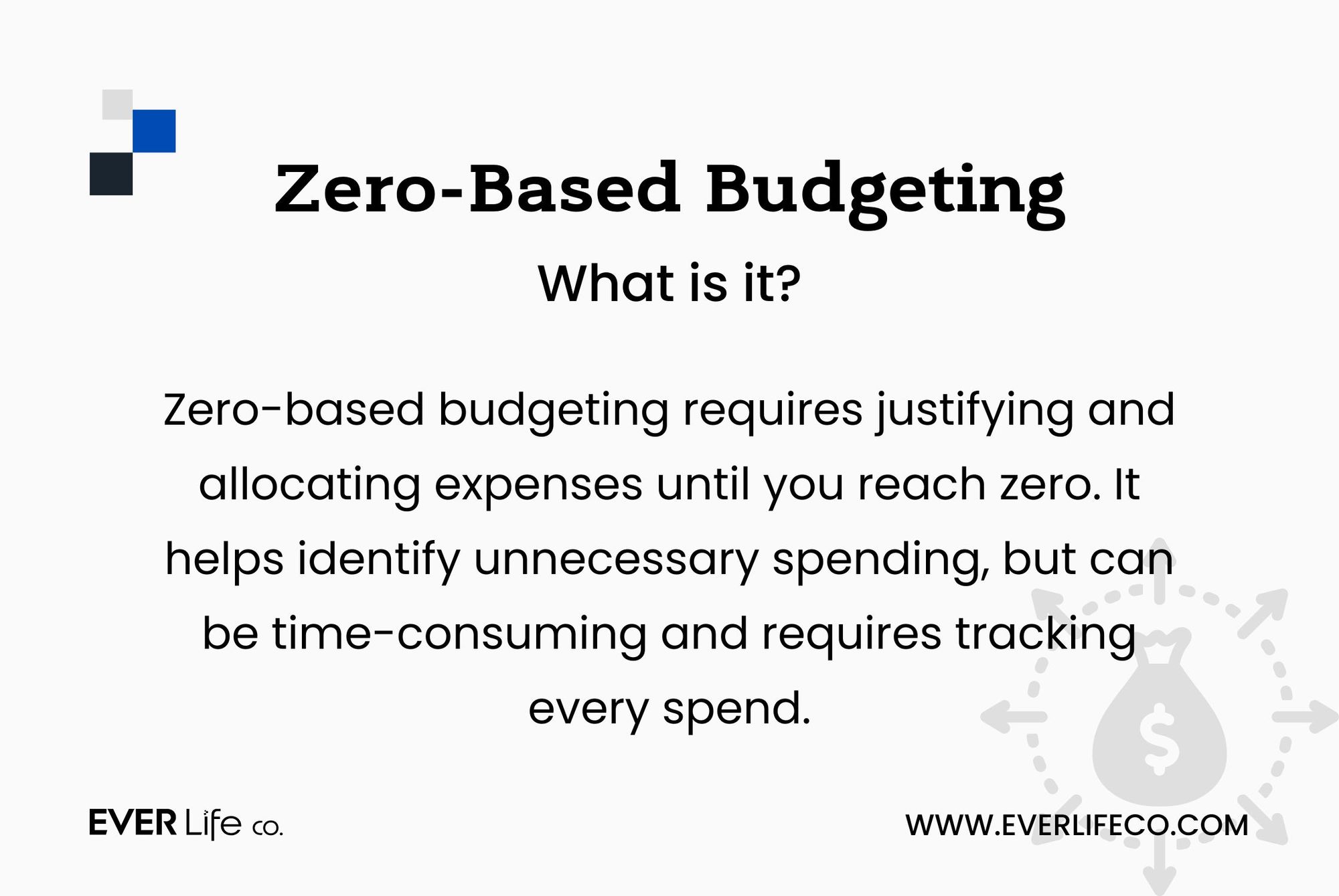
B. Envelope Budgeting
Definition and Overview:
Envelope budgeting is a system that allocates cash into envelopes labeled for specific expense categories, such as groceries or entertainment. This system is designed to help people stick to their budget by ensuring that they only spend what they have allocated for each category.
How It Works:
In envelope budgeting, you create a budget that includes all your income and expenses. You then allocate cash into envelopes labeled for each expense category. When you need to make a purchase in a particular category, you can only use the cash from that envelope. This helps you stay on track with your budget and avoid overspending.
Pros:
- Helps you control your spending and avoid overspending in a particular category.
- Can be useful for those who prefer cash-based transactions and want to avoid credit card debt.
- Provides a clear visual representation of your spending habits and how much money you have left in each category.
- Can be an effective way to save money since you are more aware of your spending habits.
Cons:
- Can be inconvenient to carry around cash for every expense category.
- Can be challenging to use for online or non-cash transactions.
- May require more time and effort to set up and maintain than other budgeting systems.
- Can be difficult to adjust for unexpected expenses or changes in income.
The envelope budgeting can be an effective budgeting system for those who prefer cash-based transactions and want to avoid overspending. By allocating cash into envelopes labeled for each expense category, you can control your spending and stay on track with your budget.
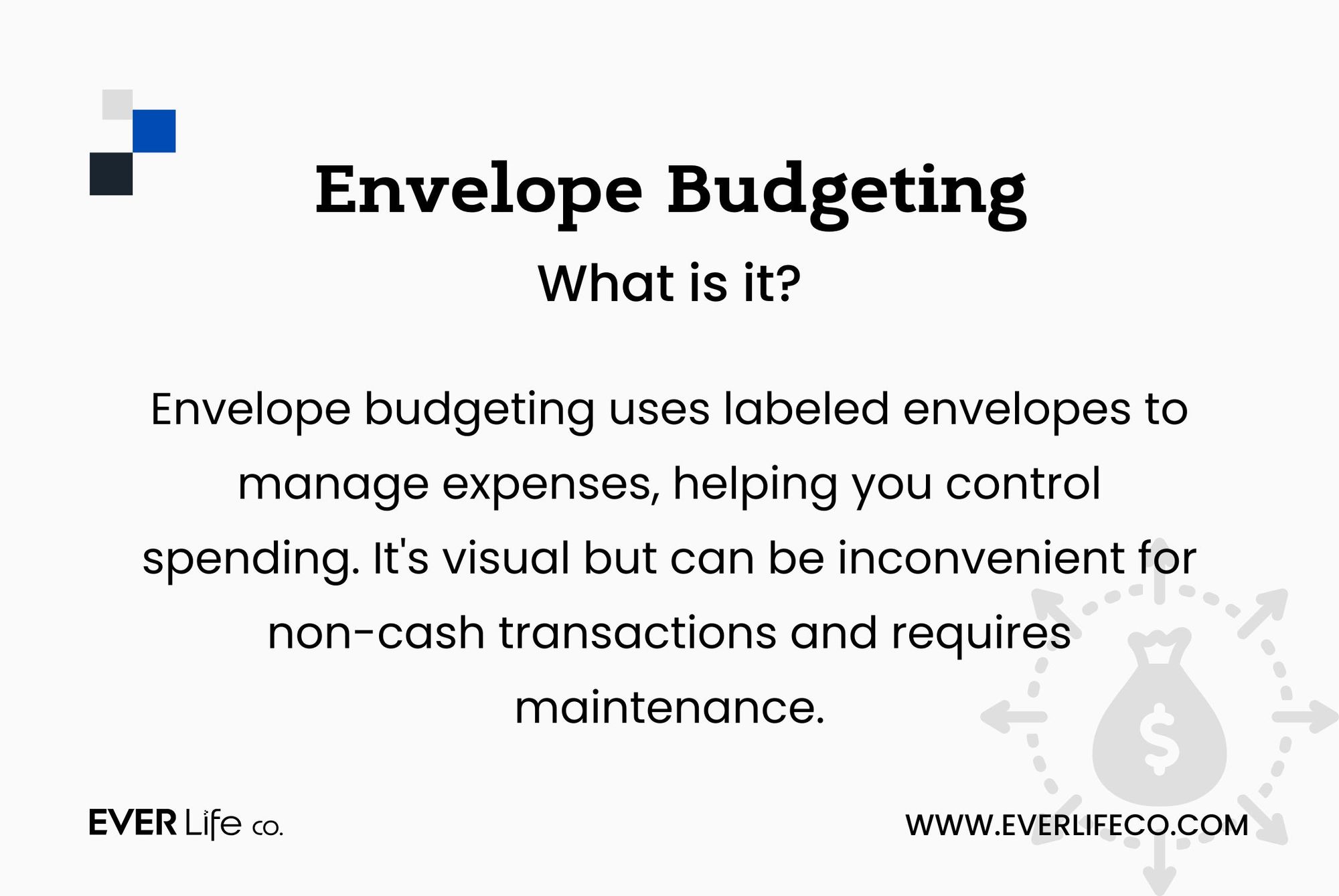
C. 50/30/20 Budgeting
Definition and Overview:
50/30/20 budgeting is a system that divides your income into three categories: 50% for necessities, 30% for discretionary spending, and 20% for savings and debt repayment.
How It Works:
In 50/30/20 budgeting, you start by determining your monthly income. You then allocate 50% of your income towards necessities such as housing, utilities, and groceries. The next 30% is allocated towards discretionary spending such as dining out, entertainment, and travel. The remaining 20% is allocated towards savings and debt repayment.
Pros:
- Provides a simple and straightforward approach to budgeting.
- Allows for flexibility and discretionary spending while still prioritizing savings and debt repayment.
- Can be effective for those with a stable income and predictable expenses.
- Can be helpful for those who struggle with impulse buying.
Cons:
- May not be suitable for those with high expenses, such as those living in high-cost areas or with large families.
- May not be effective for those with irregular income or significant fluctuations in monthly expenses.
- May not allocate enough money towards debt repayment for those with significant debt.
The 50/30/20 budgeting can be effective for those who want to balance their expenses with their savings and debt repayment goals. By prioritizing necessities, discretionary spending, and savings/debt repayment, you can create a balanced and achievable budget that helps you achieve your financial goals.
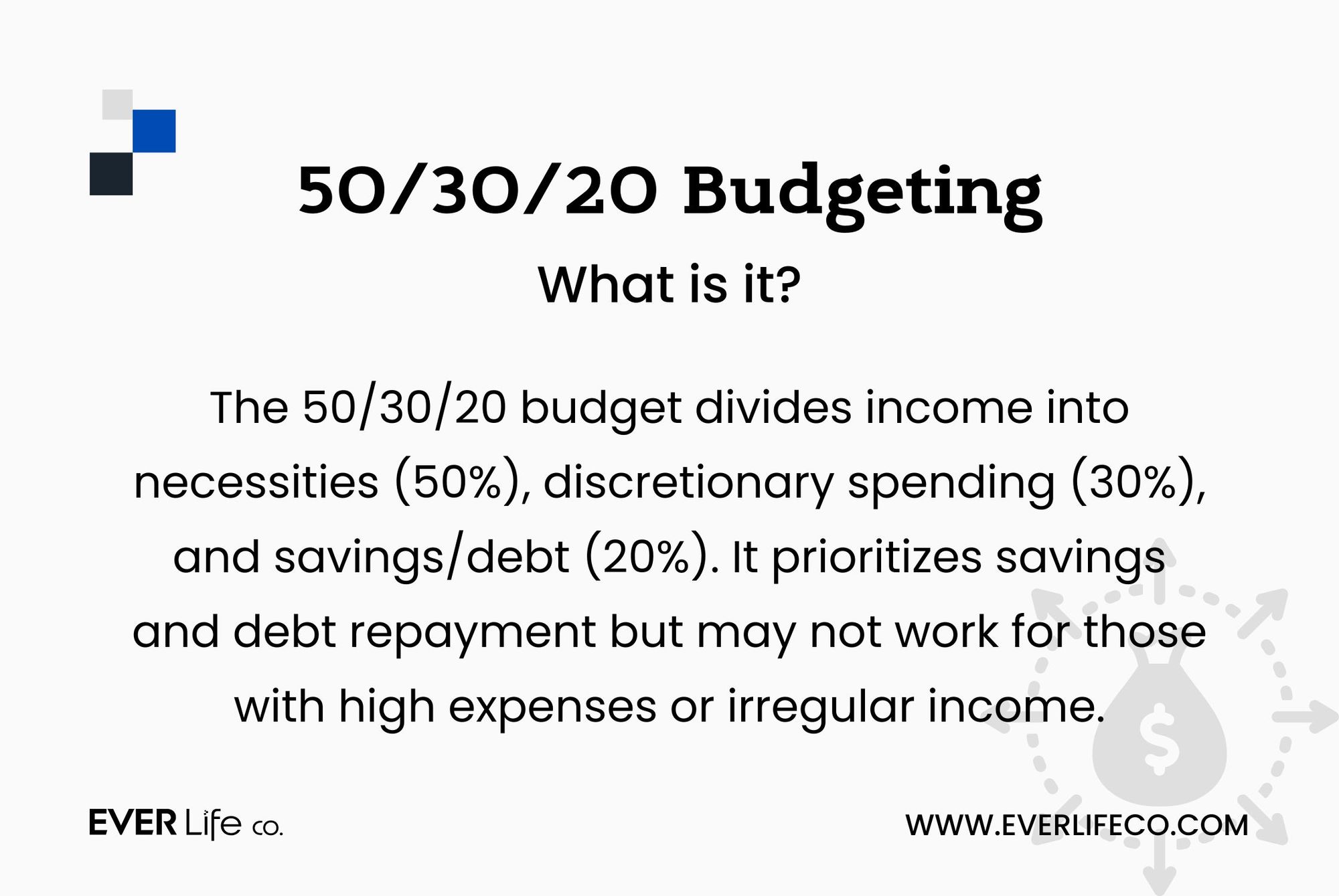
D. Priority-Based Budgeting
Definition and Overview:
Priority-based budgeting is a budgeting system that involves prioritizing expenses based on their importance and impact on your financial goals. This system is designed to help you focus on the most critical expenses and ensure that you have enough money to cover your essential needs.
How It Works:
In priority-based budgeting, you start by listing all of your expenses and categorizing them based on their priority. Essential expenses, such as housing and utilities, are given the highest priority, while non-essential expenses, such as dining out or entertainment, are given a lower priority. You then allocate your income towards each expense category in order of priority, ensuring that you have enough money to cover your essential needs first.
Pros:
- Helps you focus on essential expenses and prioritize your spending.
- Can be effective for those with irregular income or those with significant fluctuations in monthly expenses.
- Provides a clear picture of your spending habits and how they align with your financial goals.
- Allows for flexibility in discretionary spending, as long as essential needs are covered first.
Cons:
- Can be challenging to determine the priority of each expense and make difficult decisions about where to allocate your income.
- May not be suitable for those with high fixed expenses or those living in high-cost areas.
- May not be effective for those who struggle with impulse buying.
The priority-based budgeting can be an effective budgeting system for those who want to prioritize their essential expenses and ensure that they have enough money to cover their needs. By focusing on the most critical expenses and prioritizing spending, you can create a budget that aligns with your financial goals and helps you achieve financial stability.
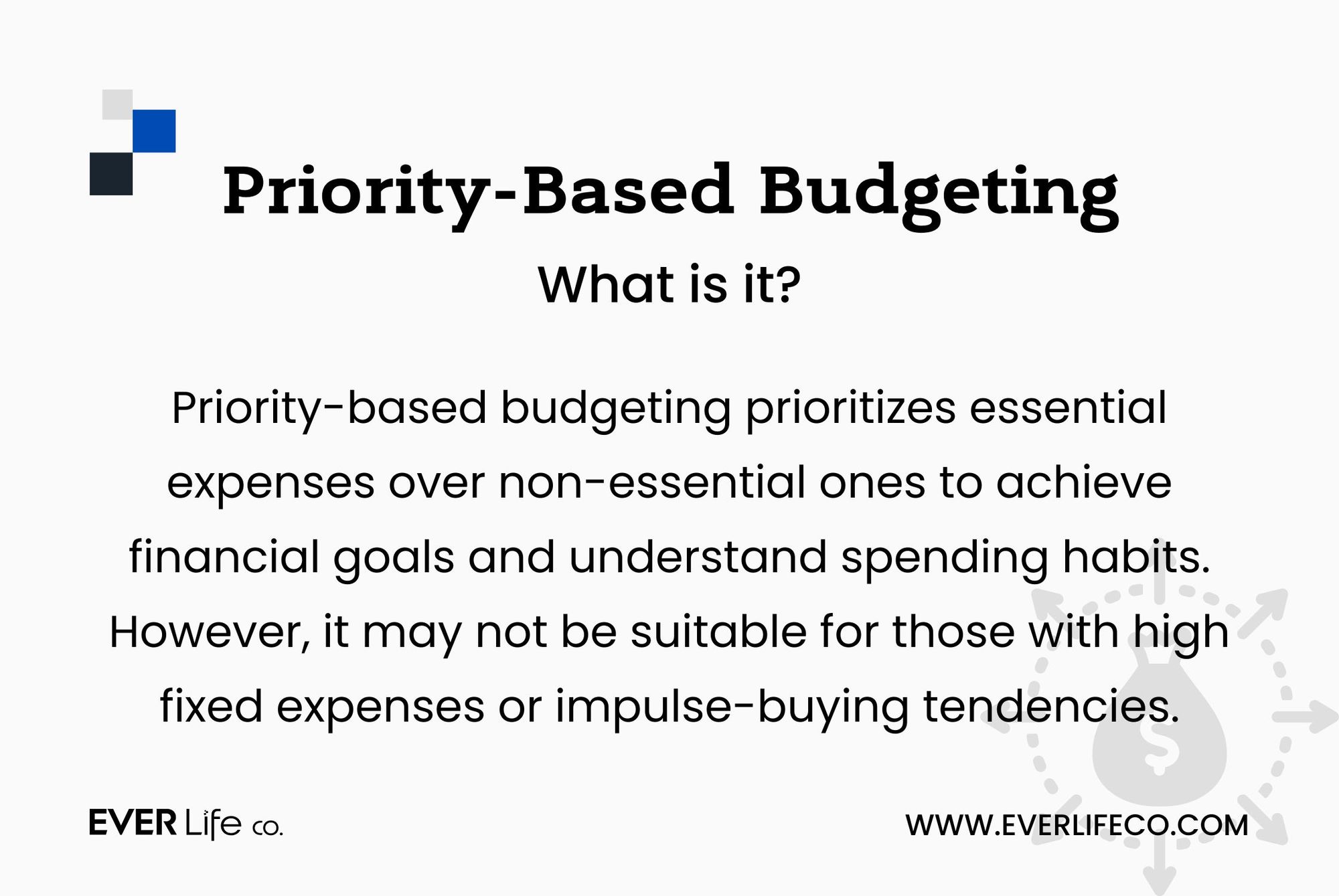
E. Value-Based Budgeting
Definition and Overview:
Value-based budgeting is a budgeting system that involves aligning your spending with your personal values and priorities. This system is designed to help you make intentional spending decisions and avoid spending money on things that don’t align with your values.
How It Works:
In value-based budgeting, you start by identifying your core values and priorities. You then create a budget that aligns with those values and priorities, ensuring that you allocate more money toward expenses that are important to you and less towards those that are not. This system allows you to make intentional spending decisions and avoid spending money on things that don’t align with your values.
Pros:
- Helps you align your spending with your personal values and priorities.
- Allows for flexibility in spending as long as expenses align with your values.
- Can be useful for those who want to avoid overspending on things that don’t bring value to their life.
- Provides a clear picture of your spending habits and how they align with your values.
Cons:
- Can be challenging to identify and prioritize your values and ensure that all expenses align with them.
- It may not be effective for those who struggle with impulse buying or have difficulty prioritizing their spending.
- May require more time and effort to set up and maintain than other budgeting systems.
The value-based budgeting can be an effective system for those who want to make intentional spending decisions and ensure that their spending aligns with their values and priorities. By focusing on what is important to you and creating a budget that reflects those values, you can create a more meaningful and fulfilling financial plan.
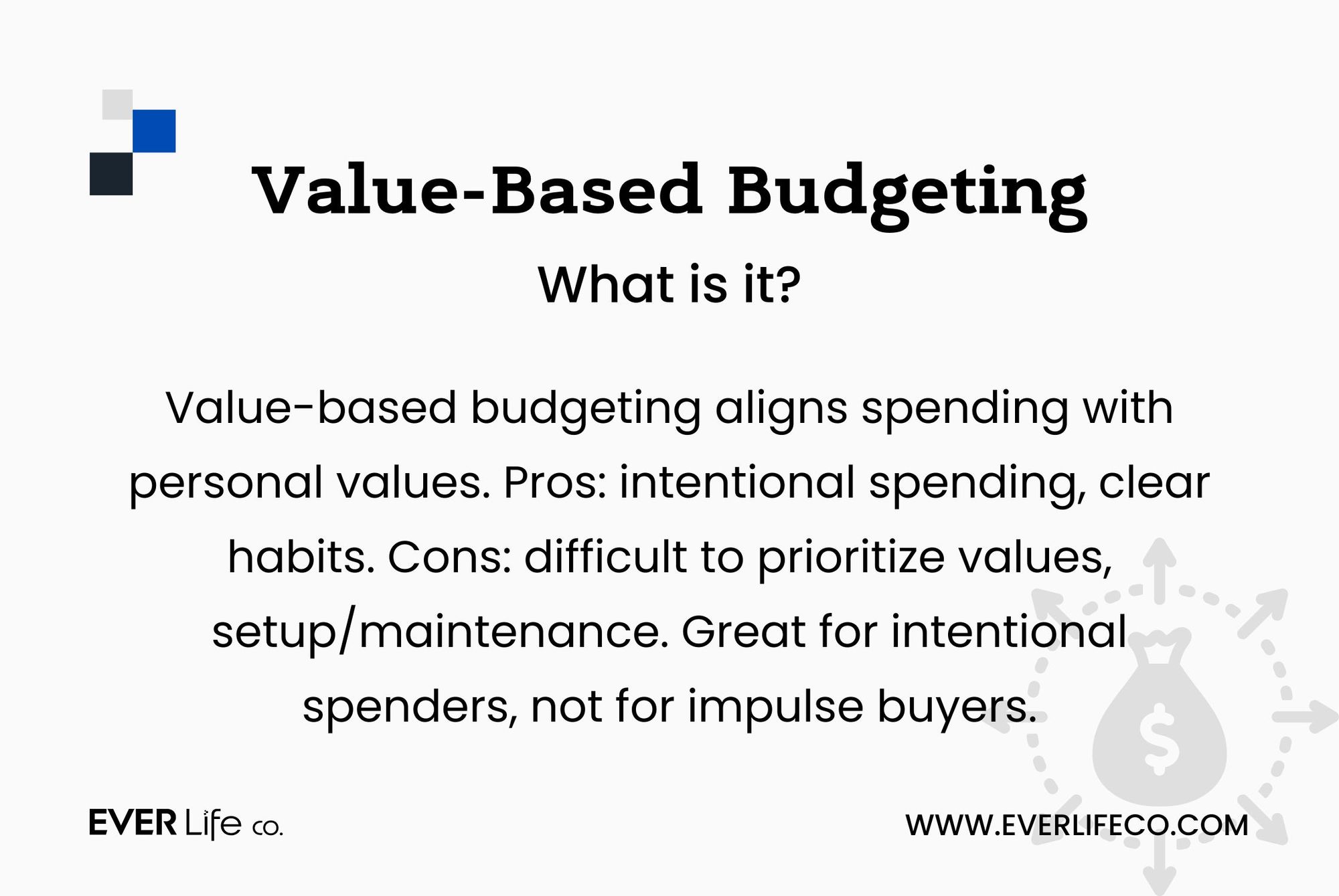
F. The Balanced Money Formula
Definition and Overview:
The Balanced Money Formula is a budgeting system developed by Elizabeth Warren and Amelia Warren Tyagi in their book “All Your Worth: The Ultimate Lifetime Money Plan.” The system is designed to help people balance their spending and achieve financial stability.
How It Works:
In the Balanced Money Formula, you start by dividing your after-tax income into three categories: 50% for essentials, 30% for discretionary spending, and 20% for savings and debt repayment. This system is similar to the 50/30/20 budgeting system but with a slight difference in the allocation of funds towards essential expenses.
Pros:
- Provides a simple and straightforward approach to budgeting.
- Allows for flexibility in discretionary spending while still prioritizing savings and debt repayment.
- Can be effective for those with a stable income and predictable expenses.
- Can be helpful for those who struggle with impulse buying.
Cons:
- May not be suitable for those with high expenses, such as those living in high-cost areas or with large families.
- May not be effective for those with irregular income or significant fluctuations in monthly expenses.
- May not allocate enough money towards debt repayment for those with significant debt.
The Balanced Money Formula can be an effective budgeting system for those who want to balance their spending and achieve financial stability. By prioritizing essentials, discretionary spending, and savings/debt repayment, you can create a balanced and achievable budget that helps you achieve your financial goals.
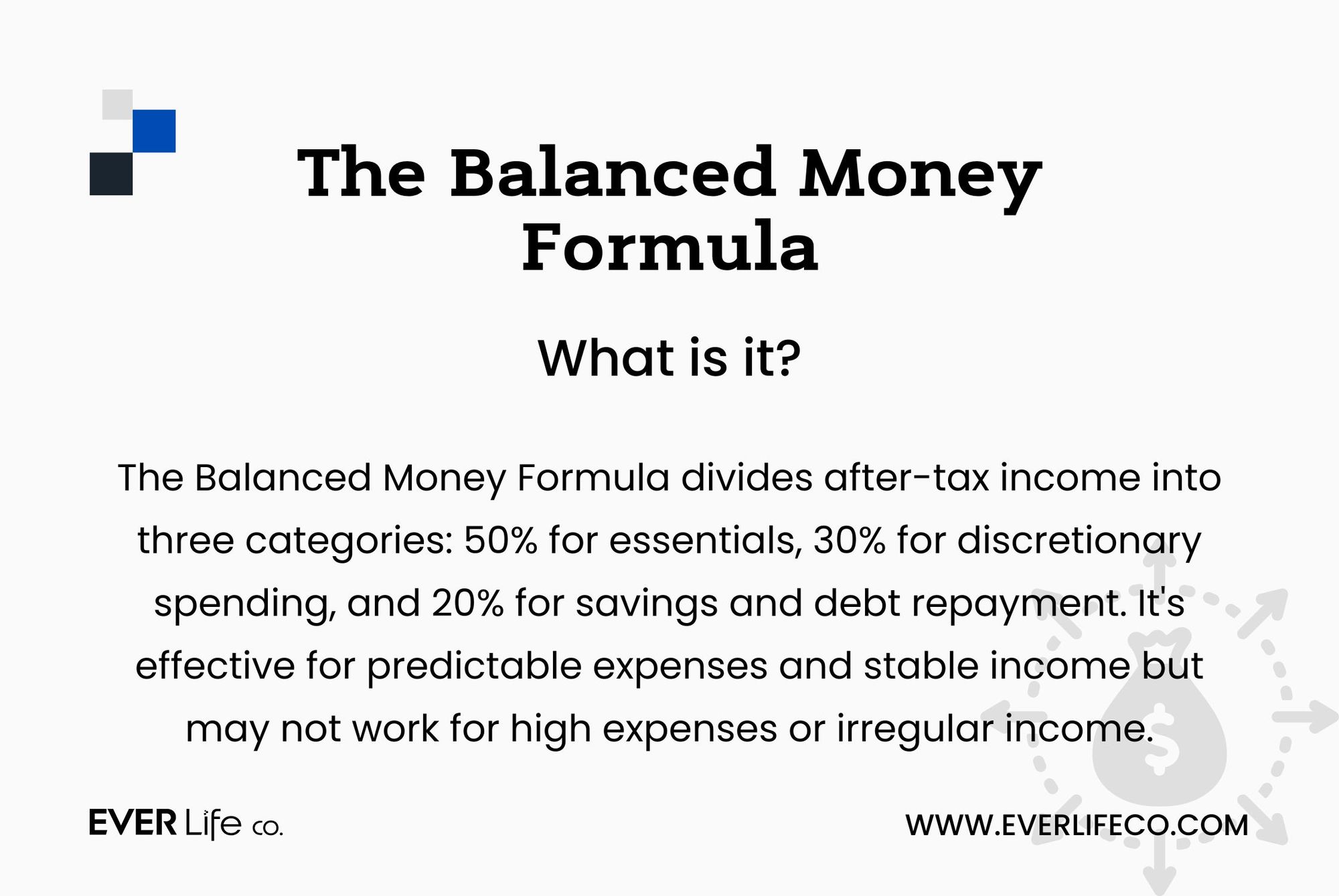
G. The Anti-Budget
Definition and Overview:
The Anti-Budget is a budgeting system that focuses on your financial priorities and cuts back on everything else. The system is designed to be flexible and adaptable to each individual’s unique financial situation.
How It Works:
In the Anti-Budget, you start by identifying your financial priorities and goals, such as paying off debt or saving for a specific purchase. You then focus your spending on those priorities and cut back on everything else. This system does not track every penny or allocate a specific amount of money to each expense category.
Pros:
- Provides a flexible and adaptable approach to budgeting.
- Allows for focus on specific financial priorities and goals.
- Can be useful for those who struggle with traditional budgeting systems.
- Can be a good starting point for those who are new to budgeting.
Cons:
- May not be effective for those with significant debt or high expenses.
- May require more discipline and self-control to stick to financial priorities and avoid overspending.
- May not provide enough structure for some individuals.
The Anti-Budget can be an effective budgeting system for those who want to focus on specific financial priorities and goals. By cutting back on everything else and directing your resources toward your financial priorities, you can achieve your financial goals and improve your financial well-being.
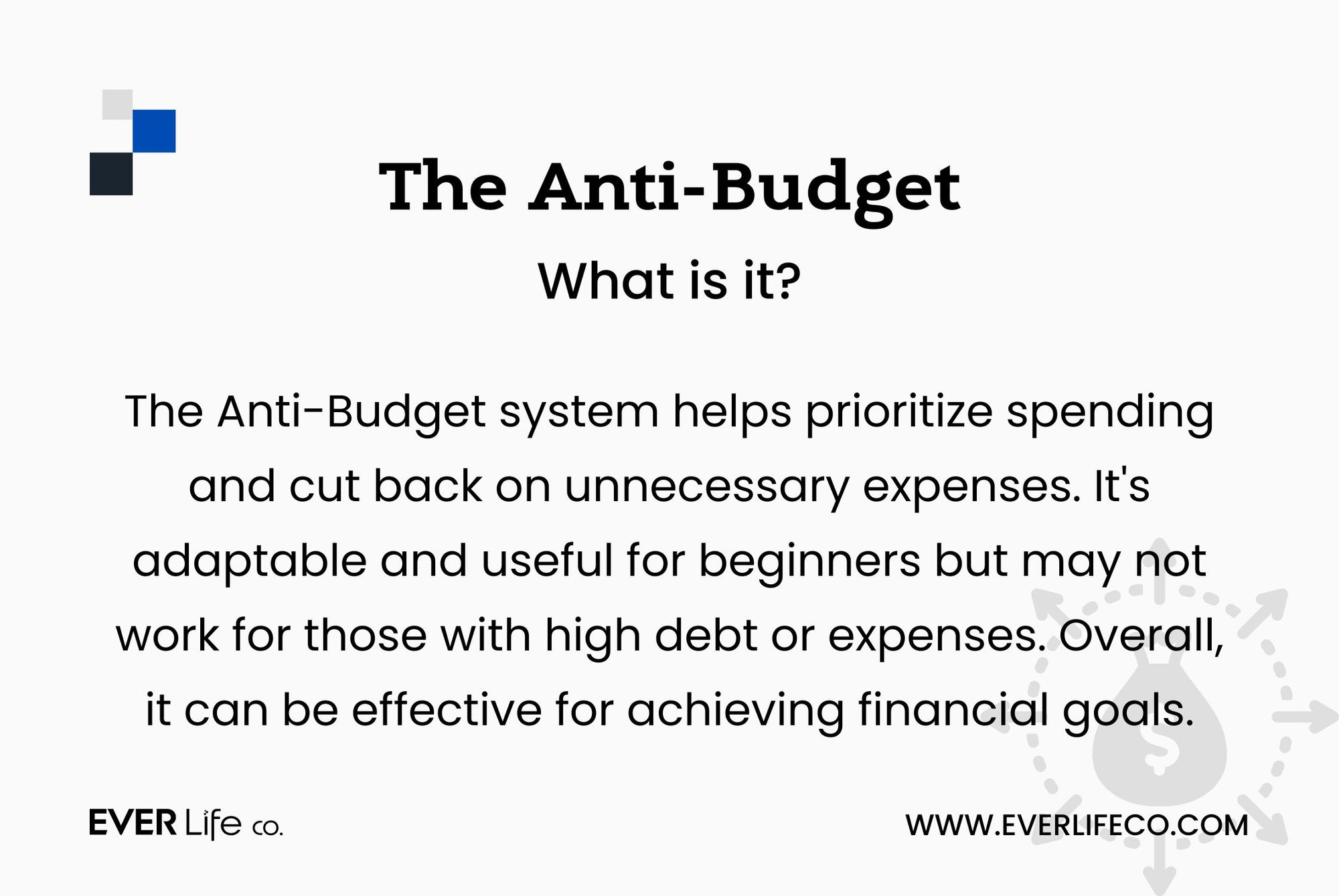
Conclusion
Budgeting is vital for managing finances, allocating resources, and achieving financial goals. By following a systematic approach, you can take control of your money, maximize savings, and ensure that financial obligations are met.
To get started with budgeting, it is crucial to prepare and audit your finances, define specific goals, organize and categorize expenses, and execute the budget using appropriate tools or tracking systems.
These steps provide a strong foundation for successful budgeting and financial stability.
Additionally, exploring different budgeting systems can help you find a method that suits your needs and preferences.
Whether it’s zero-based budgeting, envelope budgeting, 50/30/20 budgeting, priority-based budgeting, value-based budgeting, the Balanced Money Formula, or the Anti-Budget, each system offers its own advantages and considerations. Choosing the right system depends on individual circumstances, financial goals, and personal preferences.
Ultimately, budgeting empowers you to make informed financial decisions, live within your means, and work towards achieving your long-term objectives. It promotes financial awareness, accountability, and discipline.
By incorporating budgeting into daily life, you can pave the way for financial success, stability, and a brighter financial future.






